#small magellanic cloud
Explore tagged Tumblr posts
Text
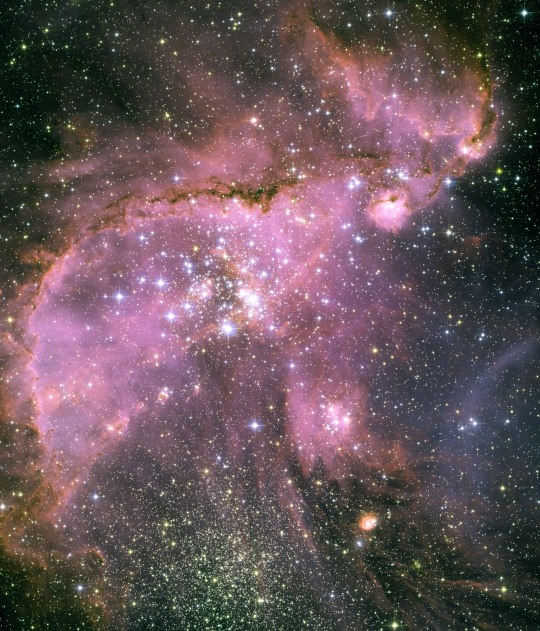
Small Magellanic Cloud
1K notes
·
View notes
Photo
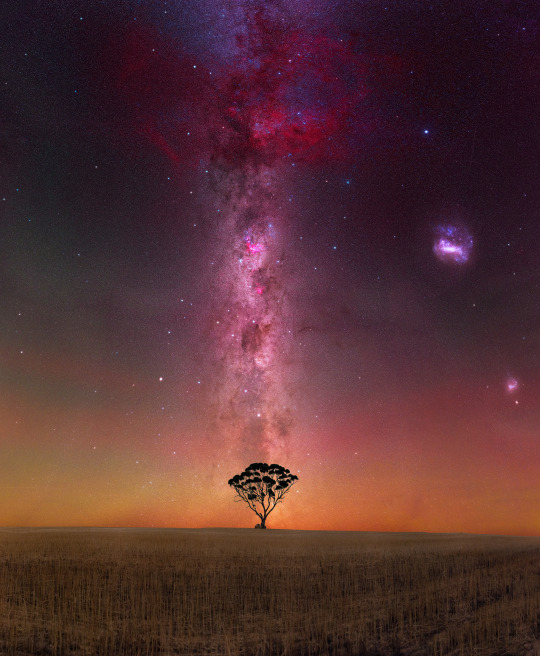
Milky Way at York, Western Australia
Nikon d810a - 50mm - ISO 6400 - f/2.5 - Foreground: 7 x 30 seconds - Sky: 35 x 30 seconds - iOptron SkyTracker - Hoya Red Intensifier filter
#Milky Way#stars#space#night#sky#Astronomy#astrophotography#landscape astrophotography#galaxy#universe#Crux#Carina#eta carinae#nebula#Magellanic Clouds#large magellanic cloud#small magellanic cloud#lone tree#gum#farm#Wheatbelt#York#Western Australia#outback
7K notes
·
View notes
Text

This young star cluster shines like a kaleidoscope thanks to the James Webb Space Telescope's near- and mid-infrared instruments. NGC 602 is in our neighboring dwarf galaxy, the Small Magellanic Cloud. Credit: ESA/Webb, NASA, CSA.
#space#astronomy#stsci#science#nasa#universe#nasawebb#james webb space telescope#jwst#webb telescope#webb space telescope#infrared#small magellanic cloud#colorful#kaleidoscope
290 notes
·
View notes
Text


[ This long-duration photograph looks out a window on the SpaceX Dragon crew spacecraft to the Large and Small Magellanic Clouds, two irregular dwarf galaxies, as the International Space Station orbited 260 miles above the Pacific Ocean off the coast of Mexico. Credit: NASA/Don Pettit ]

[ This long-duration photograph looks out a window on the SpaceX Dragon crew spacecraft to the Large and Small Magellanic Clouds, two irregular dwarf galaxies, as the International Space Station orbited 260 miles above the Pacific Ocean northeast of Australia. Credit: NASA/Don Pettit ]

[ This long-duration photograph looks out a window on the SpaceX Dragon crew spacecraft to the Milky Way as the International Space Station orbited 262 miles above the Pacific Ocean northeast of New Zealand. Credit: NASA/Don Pettit ]
#SpaceX Dragon#Milky Way#International Space Station#Small Magellanic Cloud#Large Magellanic Cloud#Magellanic Clouds#space#astronomy#astrophotography#religion is a mental illness
34 notes
·
View notes
Text

The UV SMC from UIT - December 20th, 1996.
"Translated from the "acronese" the title reads - The UltraViolet Small Magellanic Cloud from the Ultraviolet Imaging Telescope. FYI, the four ultraviolet images used in this mosaic of the nearby irregular galaxy known as the Small Magellanic Cloud were taken by the UIT instrument during the Astro 1 and Astro 2 shuttle missions in 1990 and 1995. Each separate image field is slightly wider than the apparent size of the full Moon. These ultraviolet pictures, shown in false-colour, must be taken above the Earth's absorbing atmosphere. They highlight concentrations of hot, newly formed stars only a few millions of years old, and reveal the progress of recent star formation in the SMC."
#nasa#space#cosmos#universe#astronomy#astrophysics#astrophotography#small magellanic cloud#ultraviolet
34 notes
·
View notes
Text
The celestial object of the day is E0102!


a supernova remnant located in the Small Magellanic Cloud. This object helps scientists study the chemistry inside stars, and it contains thousands of times more oxygen than the entire solar system!
#Image credit 1: X-ray (NASA/CXC/MIT/D.Dewey et al. & NASA/CXC/SAO/J.DePasquale); Optical (NASA/STScI)#Image credit 2: X-ray (NASA/CXC/ESO/F.Vogt et al); Optical (ESO/VLT/MUSE) Optical (NASA/STScI)#It also contains the first neutron star discovered outside the milky way!!#I got inspired by a book about the history of astronomy where this object was mentioned sooo hi#astronomy#astrophotography#space#outer space#nasa#nasa photos#science#supernova#Small magellanic cloud#space photography#space exploration#Celestial object of the day
45 notes
·
View notes
Text
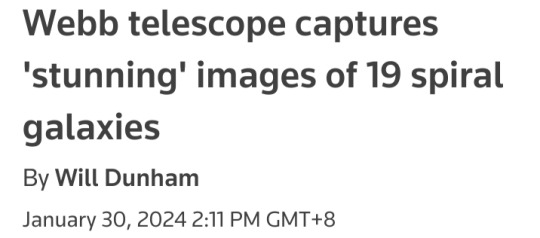
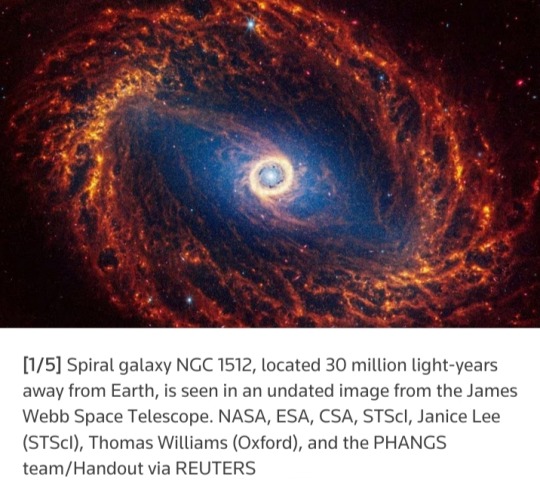
WASHINGTON, Jan 29 (Reuters) — A batch of newly released images captured by the James Webb Space Telescope show in remarkable detail 19 spiral galaxies residing relatively near our Milky Way, offering new clues on star formation as well as galactic structure and evolution.
The images were made public on Monday by a team of scientists involved in a project called Physics at High Angular resolution in Nearby GalaxieS (PHANGS) that operates across several major astronomical observatories.
The closest of the 19 galaxies is called NGC5068, about 15 million light years from Earth, and the most distant of them is NGC1365, about 60 million light years from Earth.
A light year is the distance light travels in a year, 5.9 trillion miles (9.5 trillion km).
The James Webb Space Telescope (JWST) was launched in 2021 and began collecting data in 2022, reshaping the understanding of the early universe while taking wondrous pictures of the cosmos.
The orbiting observatory looks at the universe mainly in the infrared.
The Hubble Space Telescope, launched in 1990 and still operational, has examined it primarily at optical and ultraviolet wavelengths.
Spiral galaxies, resembling enormous pinwheels, are a common galaxy type. Our Milky Way is one.
The new observations came from Webb's Near-Infrared Camera (NIRCam) and Mid-Infrared Instrument (MIRI).
They show roughly 100,000 star clusters and millions or perhaps billions of individual stars.
"These data are important as they give us a new view on the earliest phase of star formation," said University of Oxford astronomer Thomas Williams, who led the team's data processing on the images.
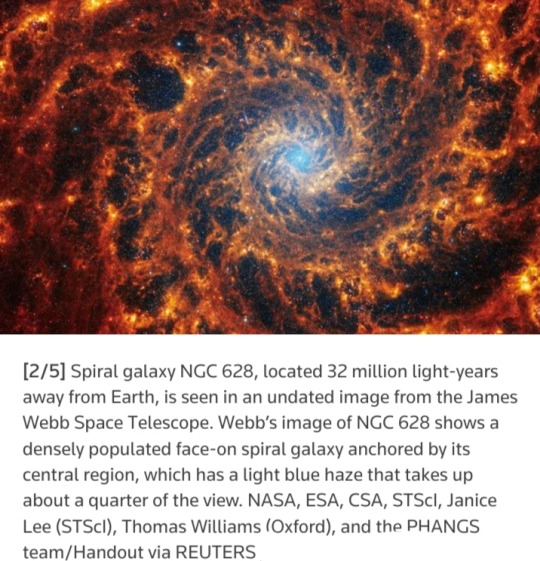
"Stars are born deep within dusty clouds that completely block out the light at visible wavelengths - what the Hubble Space Telescope is sensitive to - but these clouds light up at the JWST wavelengths.
We don't know a lot about this phase, not even really how long it lasts, and so these data will be vital for understanding how stars in galaxies start their lives," Williams added.
About half of spiral galaxies have a straight structure, called a bar, coming out from the galactic center to which the spiral arms are attached.
"The commonly held thought is that galaxies form from the inside-out, and so get bigger and bigger over their lifetimes.
The spiral arms act to sweep up the gas that will form into stars, and the bars act to funnel that same gas in towards the central black hole of the galaxy," Williams said.
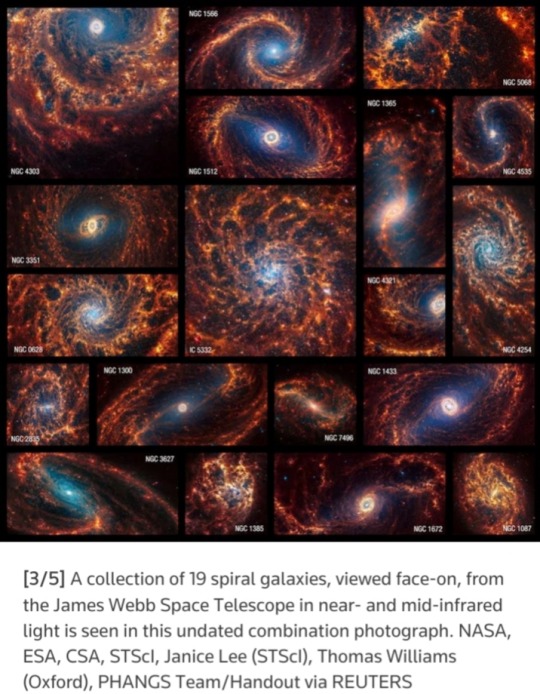
The images let scientists for the first time resolve the structure of the clouds of dust and gas from which stars and planets form at a high level of detail in galaxies beyond the Large Magellanic Cloud and Small Magellanic Cloud, two galaxies considered galactic satellites of the sprawling Milky Way.
"The images are not only aesthetically stunning, they also tell a story about the cycle of star formation and feedback, which is the energy and momentum released by young stars into the space between stars," said astronomer Janice Lee of the Space Telescope Science Institute in Baltimore, principal investigator for the new data.
"It actually looks like there was explosive activity and clearing of the dust and gas on both cluster and kiloparsec (roughly 3,000 light years) scales.
The dynamic process of the overall star formation cycle becomes obvious and qualitatively accessible, even for the public, which makes the images compelling on many different levels," Lee added.
Webb's observations build on Hubble's.
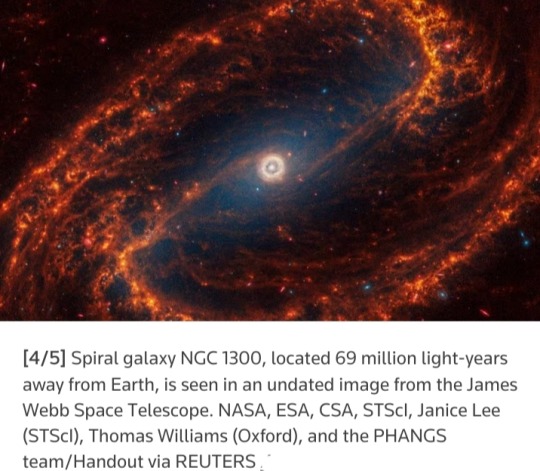
"Using Hubble, we would see the starlight from galaxies, but some of the light was blocked by the dust of galaxies," University of Alberta astronomer Erik Rosolowsky said.
"This limitation made it hard to understand parts of how a galaxy operates as a system. With Webb's view in the infrared, we can see through this dust to see stars behind and within the enshrouding dust."
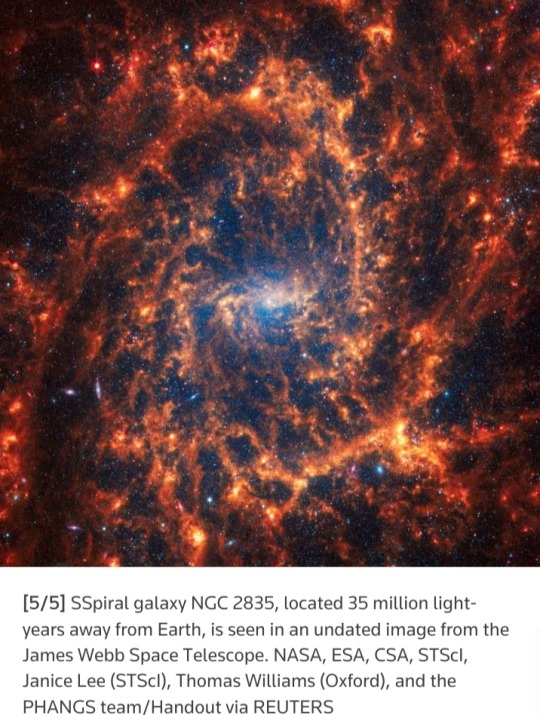
#James Webb Space Telescope#spiral galaxies#Milky Way#Physics at High Angular resolution in Nearby GalaxieS (PHANGS)#NGC5068#NGC1365#light year#Hubble Space Telescope#Near-Infrared Camera (NIRCam)#Mid-Infrared Instrument (MIRI)#astronomy#space#universe#cosmos#Large Magellanic Cloud#Small Magellanic Cloud#Space Telescope Science Institute
37 notes
·
View notes
Text
Magellany (Redo) (Nebulite)
Move out of the way, here comes the greatest adventurer in the whole damn galaxy: Magellany!
"Just call me Mag!"
She is brave, strong and... acts before thinking. She gets irritated easily, especially when people get in her way, calling them get-in-the-ways. Magellany is very rude and honest, never holding back on any comments.
She is a Nebulite, a peculiar species of sentient nebulae. Her body composition makes it possible to morph into any form as she wishes. She is not confined to a humanoid body. Her preferred weapon is her trusty Scimistar.
This magical sword is a projection of her soul which is located on her chest, in the shape of a crystal. Her power comes from this object and is also her weak point.

Nebulites have incredible capabilities for Cosmic Magic. While not on the same level as someone like Mr. Sky, they are capable of creating spontaneous life. They do so to help with tasks or do jobs that might be dangerous for them. These rudimentary organisms can last as long as the user needs them to. Their intelligence is very limited though.
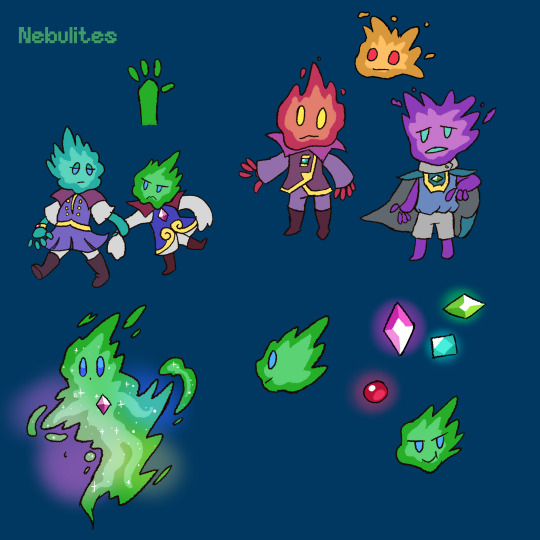
Nebulites. Mag and her older sister depicted here
She is not good with this ability though since nobody taught her and so the most she can do is use raw life energy to create primitive beings that she uses as weapons.
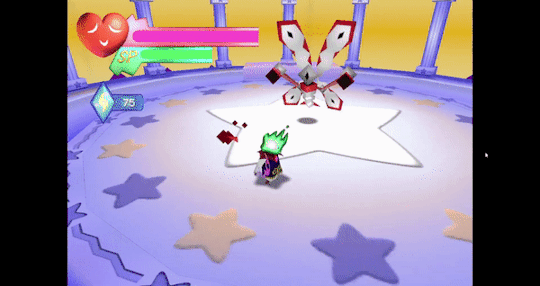
In Soul Trail, her special attack is making a little dude that goes in a straight line and damages far away opponents. Once I restart development I plan on adding more of this ability to her move set.
She claims to hear voices from space. Her favorite animals are tarantulas and she really likes long sleeved clothing along with robes.

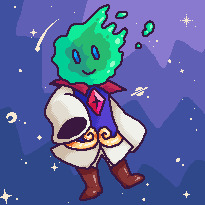

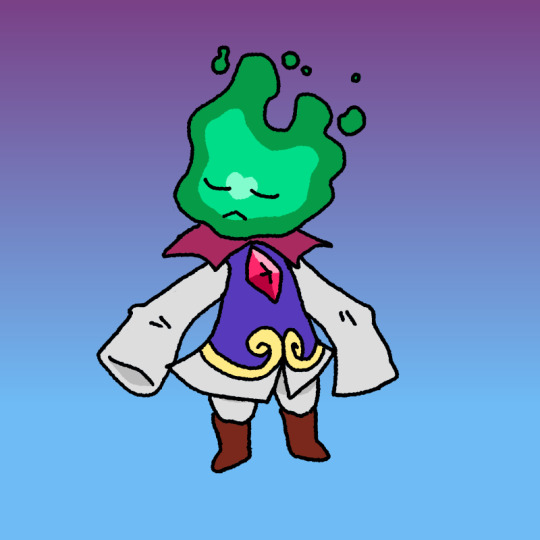
Random works of her made over the years
Backstory
She lives in a solitary planet with her older sister, Nube. Their parents are long gone and so her sister takes care of her and usually does what is best for her. Mag attends navigation classes at some kind of academy and she hates it there. Often daydreaming of what could be is she were able to sail out into space on a ship of her own with treasures to find, foes to defeat, and people to befriend. All in her own way without anyone telling her what to do.
Beneath all her harshness hides a lonely girl who only wants friends and a life she can have control over. Her short-lived creations are the only creatures who stay by her side.

Her creations only live for minutes. She likes to sit on the roof of her house and talk to them
One day something really big would happen that would change her whole life...
Inspiration
As mentioned in the post, she is a nebula; a space cloud. She is meant to be the Magellanic Cloud (hence her name) and her coloration is taken from NGC 2074. The powers Nebulites have of creating life is a reference to how all planets are born from nebulae, this could eventually lead to the creation of life within these planets.
She was the first character made for this project and has gone through some changes over the years.
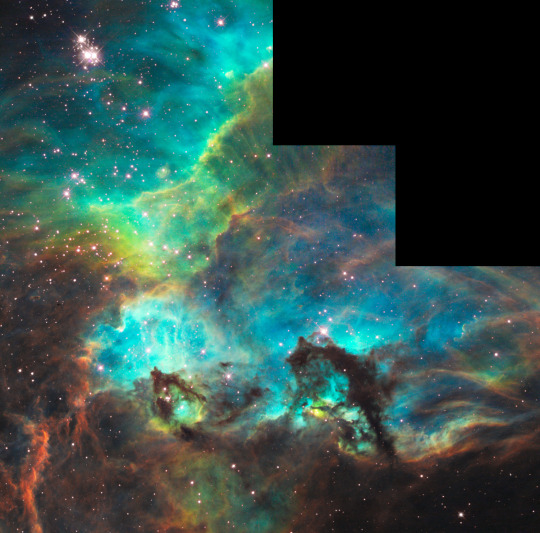
NGC 2074. Fun fact, this photo was taken in my birthday! (Photo credit to NASA)
As for her clothes and design, I was really into Kirby at the time and so many of my early designs sort of looked like spacey Kirby-ish inspired creatures.
This was a much needed redo of my first post on Tumblr.

Her very first drawing. Made in 2019. She used to have a sort of visible skull.
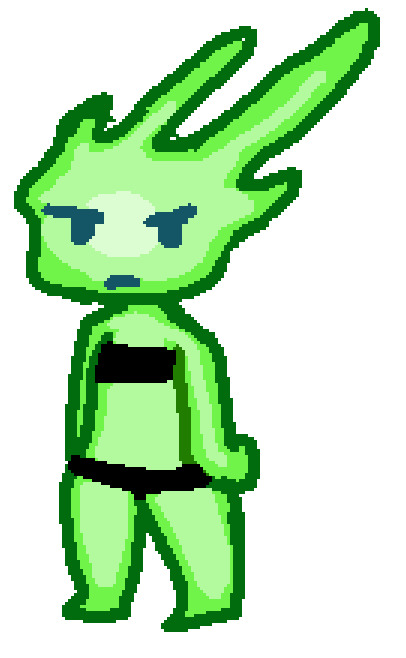
Mildly annoyed. Drawn by @blaz-art
Addendum
It just came to me her outfit was totally inspired by Toon Link from The Legend of Zelda along with her proportions and body shape. Idk why I forgot lol.
Pretty busy at the moment still btw, but still making stuff.

#3d modeling#blender#original character#digital art#art#original oc#gamedev#space#soul trail#ambystoman#lowpoly#nebula#large magellanic cloud#small magellanic cloud
18 notes
·
View notes
Text
oh hey turns out the small magellanic cloud was actually two galaxies, one in front of another
this too, is yuri
8 notes
·
View notes
Text

I used to see pictures like these and wonder if it would be more peaceful somehow being out there in Space; just floating around, no direction, no real purpose, just existing...
Until I realised that's exactly what we're already doing
💜🪽🌟
#nasa#hubble#milky way#space#astronomy#existentialism#existential crisis#existential dread#nebula#stars#fireangelsstuff#life quotes#philosophy#magellan#astrophotography#do you ever think about dying#small magellanic cloud
3 notes
·
View notes
Text

An article published in "The Astrophysical Journal" reports the identification of 64 brown dwarf candidates in the star cluster NGC 602 in the Small Magellanic Cloud, one of the Milky Way's satellite galaxies. A team of researchers used the James Webb Space Telescope to obtain the sensitivity and resolution needed to detect possible objects halfway between the planet and the star about 200,000 light-years away. Follow-up studies are needed to verify these candidates, the first brown dwarfs to be verified outside the Milky Way. NGC 602 is poor in elements heavier than hydrogen and helium, a condition that was normal when the universe was young, further reason for interest in studying the processes within the cluster.
0 notes
Photo
[source]

Milky Way with Airglow Australis
Credits: Yuri Beletsky, Carnegie, Las Campanas Observatory, TWAN
#reblog#apod#astrophotography#milky way#airglow#summer triangle#vega#α lyrae#lyra#altair#α aquilae#aquila#deneb#α cygni#cygnus#arcturus#α boötis#boötes#large magellanic cloud#small magellanic cloud#chile#yuri beletsky
87 notes
·
View notes
Text

Midnight Rainbow - by CapturingTheNight
Aurora Australis, light pollution, Zodiacal Light, The Large and Small Magellanic Clouds and The Milky Way.
Southern NSW, Australia 9-10-2012
#celestial enrichment#under the milky way#night sky#under starry skies#constellations#celestial ceiling#celestial odyssey#milky way#under the heavens#under the northern lights#starry night#the stars#stellar enrichment#stellar odyssey#under the stars#large magellanic cloud#small magellanic cloud#magellanic clouds#celestial#stellar#stars#under the starry skies#starry sky#starry skies#starry#under the milkyway#the milky way#night photography#timelapse
0 notes
Text

The Small Magellanic Cloud (right) and 47 Tucanae (lower left) // Avhinav
#astronomy#astrophotography#stars#star cluster#globular cluster#47 Tucanae#NGC 104#galaxy#dwarf galaxy#magellanic galaxy#small magellanic cloud#SMC#tucana#hydrus
56 notes
·
View notes
Text

Pequeña Nube de Magallanes
#astronomy#galaxy#small magellanic cloud#stars#space#astronomía#galaxia#pequeña nube de magallanes#estrellas#espacio
1 note
·
View note
Text

7,000 Stars and the Milky Way - February 13th, 1996.
"This panorama view of the sky is really a drawing. It was made in the 1940s under the supervision of astronomer Knut Lundmark at the Lund Observatory in Sweden. To create the picture, draftsmen used a mathematical distortion to map the entire sky onto an oval shaped image, with the plane of our Milky Way galaxy along the center and the north galactic pole at the top. 7,000 individual stars are shown as white dots, size indicating brightness. The "Milky Way" clouds, actually the combined light of dim, unresolved stars in the densely populated galactic plane, are accurately painted on, interrupted by dramatic dark dust lanes. The overall effect is photographic in quality and represents the visible sky. Orion is at the right edge of the picture, just below the galactic plane, and the Large and Small Magellanic Clouds are visible as fuzzy patches in the lower right quadrant."
#nasa#space#cosmos#universe#astronomy#astrophysics#astrophotography#milky way#stars#orion#large magellanic cloud#small magellanic cloud
41 notes
·
View notes